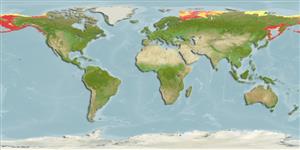分類 / Names
俗名 | 同種異名 | Catalog of Fishes(屬, 種) | ITIS | CoL | WoRMS | Cloffa
Teleostei >
Osmeriformes (Freshwater smelts)
胡瓜魚目 (Freshwater smelts) >
Osmeridae (Smelts)
胡瓜魚科 (Smelts)
Etymology: Osmerus: Greek, osme = odorous; similar to freshly cut cucumbers (Ref. 45335).
More on authors: Steindachner & Kner.
Environment: milieu / climate zone / depth range / distribution range
生態學
海洋; 淡水; 半鹹淡水; 溯河洄游 (Ref. 51243); 深度上下限 0 - 290 m (Ref. 50550). 極; 77°N - 39°N, 35°E - 123°W
North Pacific and Arctic: Wonsan, North Korea and the Sea of Okhotsk to Barkley Sound, British Columbia, north to the Bering Sea and the Arctic (Ref. 6793). Estuaries and coastal waters of European and Siberian shores of Arctic ocean from White Sea to Chukota in eastern Siberia (Ref. 59043).
北太平洋: 到 Barkley 聲音, 卑詩省的 Wonsan, 北韓與鄂霍次克海,北至白令海與北極圈。 也從白海.(參考文獻 10281)
Length at first maturity / 大小 / 重量 / 年齡
Maturity: Lm 15.0, range 14 - 16 cm
Max length : 34.0 cm SL 雄魚/尚未辨別雌雄; (Ref. 59043); common length : 14.9 cm TL 雄魚/尚未辨別雌雄; (Ref. 12193); 最大體重: 119.00 g (Ref. 56483); 最大年齡: 11 年 (Ref. 59043)
背棘 (總數) : 0; 背的軟條 (總數) : 8 - 11; 臀棘: 0; 臀鰭軟條: 12 - 16; 脊椎骨: 63 - 68. Adipose small, sickle shaped (Ref. 6885). Olive green above, shading to silvery below, a bright clearly bounded longitudinal silvery band, becoming dark in preserved specimens; speckled with black on top of head, chin and upper part of body, more plentifully along mid-dorsal line (Ref. 6885).
脂肪的小, 鐮刀形狀的.(參考文獻 6885) 橄欖綠色的上方, 顏色變化成下面銀色的, 一明亮的清楚地跳躍了縱向的銀色條紋, 在保存的標本中變成深色; 有在身體的頭頂,下巴與上半部上的黑色的斑點了, 更許多沿著背部中央線.(參考文獻 6885)
Inhabits brackish water of estuaries, lagoons, coastal shallows and bays, and fresh water in lowland and piedmont rivers (Ref. 59043). A schooling species that inhabits lakes or inshore coastal waters (Ref. 1998). Pelagic at the sea where it occurs at 4-8 m depth (Ref. 59043). In the spring, it leaves the sea or the lake and ascends freshwater streams to spawn. Some remain in fresh water throughout their lives (Ref. 1998); those that enter the sea stay within 8 to 10 km of the shore and probably do not stray far along the coast from the estuary (Ref. 28996). Spawns in rapids, in clear water, over stone-gravel bottom and at depth of 0.2-0.5 m (Ref. 59043). Possibly found up to 425 m depth (Ref. 6793). Young-of-the-year feed mostly on copepods and cladocerans, also rotifers, eggs and algae; adults feed on small crustaceans, fishes and shellfish, also squid, worms, and various insects (Ref. 27547). Feeding virtually ceases during spawning (Ref. 27547). Females grow faster, get bigger and live longer than males (Ref. 27547). Highly esteemed as a food fish ever since white men came to North America (Ref. 27547). Flesh is firm and tasty (Ref. 27547).
居住於湖或沿海地區沿岸水域的一個群游性魚種.(參考文獻 1998) 在春天,它離開海洋或者湖而且上溯到淡水溪流產卵。 一些在他們的生命各處逗留在淡水;(參考文獻 1998) 進入海岸的 8 到 10 公里裡面的海洋停留而且可能不遙遠地迷路的那些沿著海岸從河口。 (參考文獻 28996) 當年的幼魚大部分吃橈腳類的動物與水蚤, 也輪蟲,卵與藻類; 成魚吃小型甲殼動物,魚與貝,也捕食烏賊,蠕蟲與各種不同的昆蟲。 (參考文獻 27547) 在產卵的時候事實上進食停止。 (參考文獻 27547) 可能地對 425 公尺深發現。 (參考文獻 6793) 雌性生長更快速地, 大而且活的較長勝於雄性.(參考文獻 27547) 深受喜愛的由作為一個食用魚至今男白人來北美洲了.(參考文獻 27547) 肉是結實而好吃的。 (參考文獻 27547)
Life cycle and mating behavior
成熟度 | 繁殖 | 產卵場 | 卵 | 孕卵數 | 仔魚
Rainbow smelt usually return to natal streams to spawn but degree of homing varies from one population to another and may be genetically controlled (Ref. 11226, 30367). Movement into the streams begins when water temperatures reach 2° to 4°C or higher. The upstream run is generally short, at most a few km (Ref. 11226, 28996). Movement to spawning grounds are usually made at night. Males reach spawning grounds an hour or so before the females. Spawning is initiated, at least in part, by the presence of the proper sex ratio in the group, which has been indicated to be no more than four males to one female (Ref. 30366, 30374). The spawning group crowd together and move upstream. Body contact between a male and female brings about a release of sperm and eggs. Only a few eggs are extruded at each spawning act (Ref. 30366), so that the act is repeated over several hours each night for several nights until all eggs are extruded. After each evening's activities, most drift downstream to the larger body of water whence they came to the spawning grounds. Some, mostly males, may remain in the spawning stream during the day. Many spawned-out fish, especially males, die after spawning, but those that survive will spawn again the following year (Ref. 27547). Lake shore spawners on the other hand move inshore in small schools and swim about over rather restricted areas, apparently without any distinct pairing. The composition of the schools change constantly, for individual fish apparently engage in spawning activities for only 15 to 30 minutes at a time, then leave the school (Ref. 30374, 30376).北太平洋: 到 Barkley 聲音, 卑詩省的 Wonsan, 北韓與鄂霍次克海,北至白令海與北極圈。 也從白海.(參考文獻 10281)
Mecklenburg, K.C., P.R. Møller and D. Steinke, 2011. Biodiversity oif the Arctic marine fishes: taxonomy and zoogeography. Marine Biodiversity 41(1):109-140. (Ref. 86838)
IUCN 瀕危狀態 (Ref. 130435: Version 2024-1)
無危 (LC) ; Date assessed: 01 January 2008
人類使用
漁業: 商業性; 游釣魚種: 是的
工具
特別的報告
下載 XML
網路資源
Estimates based on models
Preferred temperature (Ref.
123201): -1.6 - 4.8, mean -0.4 °C (based on 2071 cells).
Phylogenetic diversity index (Ref.
82804): PD
50 = 0.5625 [Uniqueness, from 0.5 = low to 2.0 = high].
Bayesian length-weight: a=0.00407 (0.00255 - 0.00651), b=3.23 (3.09 - 3.37), in cm total length, based on LWR estimates for this species & (Sub)family-body (Ref.
93245).
營養階層 (Ref.
69278): 4.2 ±0.0 se; based on diet studies.
Generation time: 9.2 ( na - na) years. Estimated as median ln(3)/K based on 1
growth studies.
回復力 (Ref.
120179): 中等的, 族群倍增時間最少 1.4 - 4.4年 (tm=2-3; tmax=7; Fec=1,700).
Fishing Vulnerability (Ref.
59153): High vulnerability (60 of 100).
